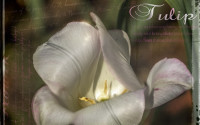Bayla
Established Forum Member
 
Posts: 555
|
Post by Bayla on Apr 26, 2015 17:31:21 GMT
 Here is what the blue channel looks like. That enhances the text. Don't remember how to extract the blue channel in Elements? - Levels (Ctrl L) - select red channel (Alt + 3) - hide it (move the right tab in the bottom output slider to zero) - select green channel (Alt + 4) - hide it (move the right tab in the bottom output slider to zero), click ok. - desaturate: Shift Ctrl U - autolevels: Shift Ctrl L Side note, although absolutely not required, all this process can be made in 16-bits mode. Do you remember how to open a jpeg in 16-bits mode in Elements? Simply open in ACR and open in the editor after setting the bit-depth menu on the middle of the bottom bar. What advantage is there to opening it in 16 bits mode? Bayla |
|
|
|
Post by michelb on Apr 26, 2015 19:27:16 GMT
 Here is what the blue channel looks like. That enhances the text. Don't remember how to extract the blue channel in Elements? - Levels (Ctrl L) - select red channel (Alt + 3) - hide it (move the right tab in the bottom output slider to zero) - select green channel (Alt + 4) - hide it (move the right tab in the bottom output slider to zero), click ok. - desaturate: Shift Ctrl U - autolevels: Shift Ctrl L Side note, although absolutely not required, all this process can be made in 16-bits mode. Do you remember how to open a jpeg in 16-bits mode in Elements? Simply open in ACR and open in the editor after setting the bit-depth menu on the middle of the bottom bar. What advantage is there to opening it in 16 bits mode? Bayla As I said, absolutely not required. In theory, the purpose of separating the channels is to get a greyscale version of each of the three colour channels. Working in greyscale in 8 bits means having 256 tones levels only. On the other hand, to be able to read the text with very low contrast means that the edit process will have to heavily 'stretch' tones to make the writing visible. Very subtle grey tone differences will be stretched possibly to black to white. Increasing the local contrast suggests that the 8-bits colour depth will produce banding and artifacts. Before adding personnal comments about this in our case, I'd like to suggest that this is a perfect test image to give the opportunity for everybody to test the difference, given that Elements can easily work in 16 bits mode except for layers, local tools and some filters. Now, my personal comments: - for our purpose, banding and artifacts are very secondary to the ability to read the writing. - There has been hot discussions about the advantage of opening an 8-bits image and converting it to 16 bits for editing. That's what happens when you edit a jpeg in ACR. I have been challenged by Pica to provide some more tests results and theoretical explanation. My results today do confirm that there is really a slight advantage. I already tried to show that advantage without success a few years ago, now I have a test protocol using the Equalize filter which confirms where 16-bits editing from an 8-bits picture is useful. However, I must say that the results have given surprising results: - With the equalizer filer, you can't show banding... but the 'equalization' effect is far better (flatter histogram). - The explanation of 'rounding errors' seems logical... but does not hold. - The explanation of 'cumulative' edits (similar to cumulative saves to jpeg) seems to be totally irrealistic in normal workflows. In ACR, there is no cumulative effects, they are all applied in a single editing session. - Those tests have been run with careful examination of histograms, to detect 'combing' and posterization risks. Now I can easily tell what the histograms really mean. There are 'combed' histograms with no visual degradation of the image... and there are fine, smooth histograms for very visible posterization! |
|
Bayla
Established Forum Member
 
Posts: 555
|
Post by Bayla on Apr 27, 2015 11:00:30 GMT
Michel,
Very interesting. I tried it out on Pat's original tulip image - & will admit that I couldn't see any difference between editing in 8 bits and editing in 16 bits, but then I imagine any difference would be very subtle.
Bayla
|
|
|
|
Post by srmoment on Apr 27, 2015 20:20:23 GMT
 This has been an interesting exercise. I had to go searching for fonts that would work for an overlay.....and then I had to go find my dictionary, which included some Latin letters (i.e. upside down e) that I could not find in a font. I added a Perfect Effects border. Thanks for all the suggestions. |
|